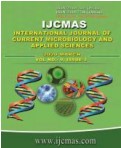


 National Academy of Agricultural Sciences (NAAS)
National Academy of Agricultural Sciences (NAAS)

|
PRINT ISSN : 2319-7692
Online ISSN : 2319-7706 Issues : 12 per year Publisher : Excellent Publishers Email : editorijcmas@gmail.com / submit@ijcmas.com Editor-in-chief: Dr.M.Prakash Index Copernicus ICV 2018: 95.39 NAAS RATING 2020: 5.38 |
The present investigation was carried out during 2018-19 in the Department of Horticulture (Fruit and Fruit Technology), BAC, Sabour to study the Efficacy of foliar feeding of brassinosteroid at different growth stage of strawberry (Fragaria × ananassa Duch.) cv. Winter Dawn for improving growth, yield and quality attributes. The experimental finding revealed that plant height, leaf size increased significantly in the treatments where brassinosteroid was applied repeatedly at vegetative, flowering and again at fruiting stage, irrespective of their concentration; however, runner per plant was recorded maximum in control (4.67). However, maximum yield per acre area (12.93 tonnes) was recorded in 0.2 ppm brassinosteroid spray each at vegetative, flowering and fruiting stage with at par result in 0.3 ppm spray each at vegetative, flowering and fruiting stage (12.92 tonnes) and 0.1 ppm spray at all these three stages (12.44 tonnes). Fruit size (length and width) as well as sugar: acid ratio were also measured significantly higher in the treatments where brassinosteroid was applied repeatedly at vegetative, flowering and again at fruiting stage, irrespective of their concentration with maximum fruit length and width in T9i.e.0.2 ppm brassinosteroid spray each at all three stages (41.73 mm and 32.60 mm, respectively) and maximum sugar :acid ratio in T5i.e.in 0.1 ppm spray at all these three stages(15.21) with minimum in control (28.32 mm, 26.03 mm and 5.50, respectively). Hence, it can be concluded that the foliar feeding of brassinosteroid repeatedly at vegetative, flowering and fruiting stage is the best treatment to increase the yield potentiality of strawberry cv. Winter Dawn with improved fruit quality under subtropical condition of Bihar, India.
 |
 |
 |
 |
 |